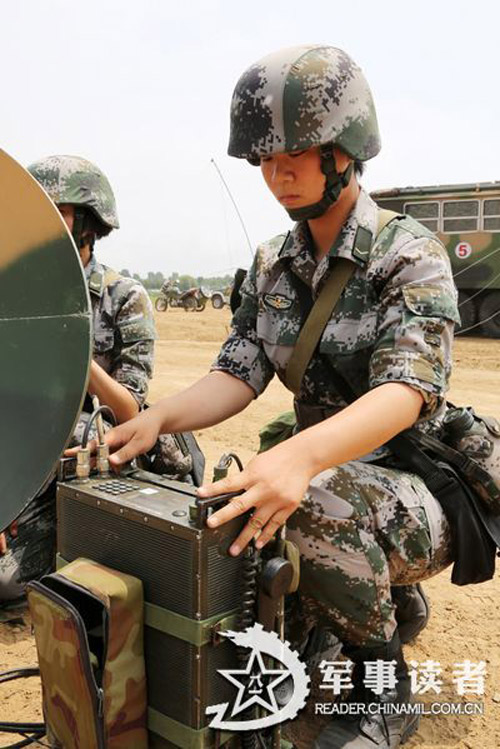
The US DOD’s annual report on the People’s Liberation Army contains some interesting discussion of the importance the force attaches to connectivity.
On 19th October, the Pentagon published its annual Military and Security Developments Involving the People’s Republic of China report. This publication provides a comprehensive assessment of the People’s Liberation Army’s (PLA) current condition, and how it may develop in the coming years. The PLA is the overarching name for China’s military services and includes its army, navy, air, nuclear and strategic support forces.
As Armada reported earlier this year, the United States Department of Defence’s (DOD) 2022 report contained some interesting insights. Of particular interest was how the People’s Liberation Army (PLA) is working towards deepening force connectivity.
Playing Catch-Up
The 2022 report revealed that the PLA is building an overarching, cross-domain Command and Control (C2) system. This effort arguably mirrors the US DOD’s Joint All-Domain Command and Control (JADC2) system. JADC2 is the manifestation of the Department of Defence’s Multi-Domain Operations (MDO) philosophy. MDO emphasises the inter- and intra-force connectivity of all military assets notably personnel, weapons, sensors, bases and capabilities at all levels of war. The purpose of MDO is to provide forces with the ability to take faster and better decisions than their adversaries. JADC2 federates several disparate operational and strategic level C2 systems used by America’s individual armed services.
According to last year’s report China’s President Xi Jinping has urged the PLA to “create a highly informatised force capable of dominating all networks and expanding the country’s security and development interests.” The goal is to ensure that information can be speedily and seamlessly moved around the battlefield. Links will be established to share data across and between ground, maritime, air, space and cyberspace domains.
As we wrote back in February, it could be argued the PLA’s own ambitions directly mirror those of the JADC2 and MDO. The DOD’s 2022 assessment said the Chinese military see “networked, technologically advanced (C2) systems as essential to providing reliable, secure communications to fixed and mobile command posts.” The goal is to improve decision-making at all levels in the armed forces. This ambition will be facilitated by embracing artificial intelligence, cloud computing and “big data analytics,” the report continued.
The assessment warned that the PLA’s desire to win and sustain information superiority, for which MDO is essential, is not an end. Information superiority will be achieved “by destroying the adversary’s ability to acquire, transmit and process information while simultaneously protecting the PLA’s ability to do the same.” Ultimately, the PLA “believes that it can successfully deter and manage a conflict by either controlling or destroying an adversary’s access to information.”
Current Assessments
One year on, what does the 2023 report tell us about the PLA’s MDO ambitions? MDO, or what the PLA calls Multi-Domain Precision Warfare (MDPW) remains a central part of Chinese military thinking. The report says that MDPW “is intended to leverage a (command and control) network that incorporates advances in big data and artificial intelligence to rapidly identify key vulnerabilities in the US operational system and then combine joint forces across domains to launch precision strikes against those vulnerabilities.”
Reading between the lines, this implies that the PLA intends to target weak points at the strategic level in US JADC2 architectures. The logic is to slow the pace of US decision-making and degrade the qualities of those decisions to thus hand the initiative to the PLA during any future confrontation. MDPW, the report says, will be realised via the “integrated development of mechanisation, informatisation, and intelligentisation (sic) of the PRC’s armed forces.” As well as being directed at the strategic level against US and allied forces, MDPW has the scope to be used by the PLA during any future attempt to invade and occupy Taiwan.
The report says that the PLA places a premium on “reliable, secure communications to fixed and mobile command posts, thereby enabling rapid, effective, multi-echelon decision making.” PLA communications links are intended to deliver real-time information across redundant and reliable networks. These links are the essential underpinning of the MDPW concept. The Integrated Command Platform (ICP) is one capability highlighted by the report. The platform seems to be a node which can be deployed at strategic, operational and tactical levels to facilitate inter-force connectivity. It is possible that the ICP provides this connectivity via conventional radio, satellite communications and possibly fibre-optic links.
The latter aims of mechanisation, informatisation and intelligentisation are to reach momentum by 2027, according to an earlier 2020 pronouncement by the PLA, the report noted. 2027 will coincide with the 100th anniversary of the founding of the Chinese Communist Party. The assessment continues that such capabilities could then be at a sufficient level to meaningfully contribute to any attempt by the PLA to invade Taiwan. Nonetheless, the report added that there appears to have been no commensurate update or redrafting of PLA doctrines to reflect the MDPW embrace. Such a shortcoming could be “an obstacle to advancing the next steps in building a unified, joint PLA.”

The lack of doctrinal synchronisation is not the only ‘known unknown’ in the PLA’s military posture. Notwithstanding the IPC, much about the communications systems, networks and protocols used by the PLA and its forces remain opaque. There is precious little mention of these subjects in the report but to be fair, information on PLA communications in the public domain is sparse.
Nonetheless, it is hard to see how the PLA can achieve its Multi-Domain Precision Warfare ambitions without a continued enhancement of its requisite strategic, operational and tactical communications. US JADC2 and MDO efforts are instructive in this regard. JADC2 and MDO efforts bring a commensurate demand for resilient, redundant and capacious communications. If the PLA is to achieve strategic overmatch vis-à-vis the US military, it must eclipse the DOD’s levels of communications modernisation. Despite the size of the Chinese economy, and the extent of the country’s technological prowess, this could still prove challenging.
by Dr. Thomas Withington












